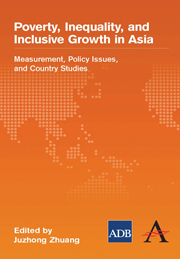Book contents
- Frontmatter
- Contents
- Foreword
- Preface and Acknowledgments
- Contributors
- Abbreviations, Acronyms, and Symbols
- Tables, Figures, and Boxes
- 1 Poverty, Inequality, and Inclusive Growth in Asia
- Part A Measuring Inequality and Poverty
- 2 Inequality and Poverty in Asia
- 3 Non-Income Poverty and Inequality in Asia
- 4 Gender Equality and Inclusive Growth in Asia
- Part B Selected Policy Issues for Inclusive Growth
- Part C Country Studies
- Index
3 - Non-Income Poverty and Inequality in Asia
from Part A - Measuring Inequality and Poverty
Published online by Cambridge University Press: 05 March 2012
- Frontmatter
- Contents
- Foreword
- Preface and Acknowledgments
- Contributors
- Abbreviations, Acronyms, and Symbols
- Tables, Figures, and Boxes
- 1 Poverty, Inequality, and Inclusive Growth in Asia
- Part A Measuring Inequality and Poverty
- 2 Inequality and Poverty in Asia
- 3 Non-Income Poverty and Inequality in Asia
- 4 Gender Equality and Inclusive Growth in Asia
- Part B Selected Policy Issues for Inclusive Growth
- Part C Country Studies
- Index
Summary
Introduction
This chapter is an overview of non-income poverty and human development in Asia. This focus is justifiable not only from an ethical and moral perspective, but also pragmatically given the importance of these issues to political and social stability. As will be discussed, human development must be viewed as an end in itself and not just a means for attaining economic growth. Nevertheless, the extent to which economic growth has not been inclusive poses a threat to growth prospects in the region. Growing socioeconomic inequality often triggers crime and political and civil unrest. The growth elasticity of poverty also tends to be higher with higher levels of human development and lower levels of income inequality.
Section 3.2 discusses the concepts and measurement of non- income poverty and inequality. Section 3.3 summarizes broad trends in non- income poverty indicators while Section 3.4 examines inequality in non-income poverty indicators, both focusing on developing Asian economies. Section 3.5 explores the relationship between income and non-income poverty, and summarizes some empirical findings. Section 3.6 concludes with a brief discussion.
Concepts and measurement of non-income poverty and inequality
In broad terms, non-income poverty refers to dimensions that go beyond the traditional monetary and consumption-driven aspects of individual and societal well-being. Whereas it is important to know the level of consumption or income of individuals and countries, it is equally important to assess the attainment of non-income “human development” welfare indicators—such as nutrition, health, and education, among others—at a given level of income or consumption.
- Type
- Chapter
- Information
- Poverty, Inequality, and Inclusive Growth in AsiaMeasurement, Policy Issues, and Country Studies, pp. 86 - 114Publisher: Anthem PressPrint publication year: 2010



